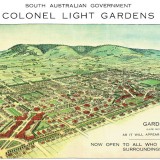City of Mitcham, Adelaide, Australia
Originally known as Mitcham Garden Suburb it was renamed Colonel Light Gardens in 1921 to honour the surveyor responsible for Adelaide’s town plan.
Developed on the 300 acre Grange Farm by Charles Reade, a New Zealand Journalist. Reade was actively involved in the Garden Cities and Town Planning Associations, after visiting England, and took design inspiration from them. The original design encompassed several garden city principles including a mix of recreational places and allotments for the community, however the introduction of the Governments ‘Thousand Homes Scheme’, in 1924, required a remodel to accommodate the additional housing, which in turn impacted on the original ideals.
1916- SA government employed Charles Reade as Australia’s first Government Town Planner Plans
1917- Reade requested to prepare plans for ‘Mitcham Garden Suburb’ as first Australian Gov Town Planner.
1919- Garden Suburb Act passed.
1921- Name ‘CLG’ adopted and first land begins to go on Sale.
1924 – 60 houses were built/occupied. Labor Government decided to initiate a mass housing project ‘Thousand Homes Scheme’ which required a remodel to accommodate additional housing, which ‘changed the whole concept of the original scheme’
1928 – The great depression has impact on housing
1940’s- Main Entrance to the suburb, Piccadilly Circus and unused shop sites were allocated for housing.
1999- Included on the Register of the National Estate and declared a State Heritage area in 2000.
Original master planner and any other critical master planning, design and architects
Designed by Charles Reade in 1917 based on his experience of the Garden City Movement. Reade left project in 1920 and surveyor Charles Davenport Harris refined the design.
Architectural Style/qualities Bungalow homes
Settlement Size 1.58km2
Population 3,237 (2006 census)
Governance arrangements
Due to financial constraints, responsibility for CLG was transferred to the City of Mitcham in 1975 and the ‘Garden Suburb act was repealed.
Local government: City of Mitcham, Gault Ward
State government: Electoral district of Waite in the South Australian House of Assembly
Federal government: Seat of Boothby in the Australian House of Representatives
Stewardship model
The introduction of the Garden Suburb Act also meant that the area could be managed by commissioners acting very similar to the Heritage Foundation in Letchworth Garden City. The key principles used and the management of the area made represent a strong example of a Garden City Suburb
Other notable features that reflect Garden City Principles
mixed-tenure homes and housing types that are affordable for ordinary people
“This site was developed in order to build housing that was affordable, but offered both Urban and Rural benefits. The introduction of the Garden Suburb Act also meant that the area could be managed by commissioners acting very similar to the Heritage Foundation in Letchworth Garden City. The key principles used and the management of the area made represent a strong example of a Garden City Suburb”
strong local cultural, recreational and shopping facilities in walkable neighbourhoods
Within the suburb, distinct areas were set aside for commercial, administrative, education, religious, recreational and residential land uses. No industrial area was created. Two shopping precincts (one with town hall, theatre and fire station nearby) were allowed for, as well as sites for schools, accommodation for the aged, a convalescent home, a returned soldiers’ facility comprising a medical institute and a technical institute, and churches.
opportunities for residents to grow their own food, including generous allotments
Reade allowed for a mix of recreation places including several large parks, a park … internal reserves placed behind groups of houses on smaller allotments and small parks dotted throughout the suburb.
Find out more:
http://www.mitchamcouncil.sa.gov.au
http://www.clghs.org.au/

